I General Introduction
1 Introduction
1.1 Organization of the Manual
1.2 Demos and Examples
1.3 Hello World
1.4 Further Reading
Reference Manual
2 Preliminaries
2.1 License Issues
2.2 Third Party Software
2.3 Marking of Advanced Features
2.4 Namespace CGAL
2.5 Inclusion Order of Header Files
2.6 Compile-time Flags to Control Inlining
2.7 Identifying the Version of CGAL
2.8 Thread Safety
2.9 Code Deprecation
2.10 Checks
Reference Manual
II Arithmetic and Algebra
3 Algebraic Foundations
3.1 Introduction
3.2 Algebraic Structures
3.3 Real Embeddable
3.4 Real Number Types
3.5 Interoperability
3.6 Fractions
Reference Manual
3.7 Classified Reference Pages
3.8 Alphabetical List of Reference Pages
4 Number Types
4.1 Introduction
4.2 Built-in Number Types
4.3 Number Types Provided by CGAL
4.4 Number Types Provided by GMP
4.5 Number Types Provided by LEDA
4.6 Number Types Provided by CORE
4.7 User-supplied Number Types
Reference Manual
4.8 Classified Reference Pages
4.9 Alphabetical List of Reference Pages
5 Polynomial
5.1 Fundamentals
5.2 General Design
5.3 Constructing a multivariate polynomial
5.4 Coefficient Access
5.5 Degree, total degree and degree vector
5.6 Changing the order of variables
5.7 GCD and More
5.8 Evaluation and Substitution
5.9 Resultants, Subresultants and Sturm-Habicht sequences
5.10 Design and Implementation History
Reference Manual
5.11 Classified Reference Pages
5.12 Alphabetical List of Reference Pages
6 Modular Arithmetic
6.1 Introduction
6.2 Design and Implementation History
Reference Manual
6.3 Classified Reference Pages
6.4 Alphabetical List of Reference Pages
III Combinatorial Algorithms
7 Monotone and Sorted Matrix Search
Reference Manual
7.1 Classified References Pages
7.2 Alphabetical List of Reference Pages
8 Linear and Quadratic Programming Solver
8.1 Which Programs can be Solved?
8.2 Design, Efficiency, and Robustness
8.3 How to Enter and Solve a Program
8.4 Solving Linear and Nonnegative Programs
8.5 Working from Iterators
8.6 Important Variables and Constraints
8.7 Solution Certificates
8.8 Customizing the Solver
8.9 Some Benchmarks for Convex Hull Containment
Reference Manual
8.10 Classified Reference Pages
8.11 Alphabetical List of Reference Pages
IV Geometry Kernels
9 2D and 3D Geometry Kernel
9.1 Introduction
9.2 Kernel Representations
9.3 Kernel Geometry
9.4 Predicates and Constructions
9.5 Extensible Kernel
9.6 Design and Implementation History
Reference Manual
9.7 Concepts
9.8 Kernel Classes and Operations
9.9 Predefined Kernels
9.10 Kernel Objects
9.11 Constants and Enumerations
9.12 Global Functions
9.13 Kernel Geometric Object Concepts
9.14 Kernel Function Object Concepts
9.15 Dimension handling tools
10 dD Geometry Kernel
10.1 Introduction
10.2 Kernel Representations
10.3 Kernel Geometry
10.4 Predicates and Constructions
10.5 Design and Implementation History
Reference Manual
10.6 Linear Algebra Concepts and Classes
10.7 Kernels
10.8 Kernel Objects
10.9 Global Kernel Functions
10.10 Kernel Concept
11 2D Circular Geometry Kernel
11.1 Introduction
11.2 Software Design
11.3 Examples
11.4 Design and Implementation History
Reference Manual
11.5 Geometric Concepts
11.6 Geometric Kernels and Classes
11.7 Geometric Global Functions
11.8 Algebraic Concepts
11.9 Algebraic Kernel and Classes
11.10 Alphabetical List of Reference Pages
12 3D Spherical Geometry Kernel
12.1 Introduction
12.2 Spherical Kernel Objects
12.3 Software Design
12.4 Examples
12.5 Design and Implementation History
Reference Manual
12.6 Geometric Concepts
12.7 Geometric Kernels and Classes
12.8 Geometric Global Functions
12.9 Algebraic Concepts
12.10 Algebraic Kernel and Classes
12.11 Alphabetical List of Reference Pages
V Convex Hull Algorithms
13 2D Convex Hulls and Extreme Points
13.1 Introduction
13.2 Convex Hull
13.3 Example using Graham-Andrew's Algorithm
13.4 Extreme Points and Hull Subsequences
13.5 Traits Classes
13.6 Convexity Checking
Reference Manual
13.7 Classified Reference Pages
13.8 Alphabetical List of Reference Pages
14 3D Convex Hulls
14.1 Introduction
14.2 Static Convex Hull Construction
14.3 Incremental Convex Hull Construction
14.4 Dynamic Convex Hull Construction
Reference Manual
14.5 Classified Reference Pages
14.6 Alphabetical List of Reference Pages
15 dD Convex Hulls and Delaunay Triangulations
15.1 Introduction
15.2 dD Convex Hull
15.3 Delaunay Triangulation
Reference Manual
15.4 Classified Reference Pages
15.5 Alphabetical List of Reference Pages
VI Polygons
16 2D Polygons
16.1 Introduction
16.2 Example
Reference Manual
16.3 Classified Reference Pages
16.4 Alphabetical List of Reference Pages
17 2D Regularized Boolean Set-Operations
17.1 Introduction
17.2 Terms and Definitions
17.3 Boolean Set-Operations on Linear Polygons
17.4 Boolean Set-Operations on General Polygons
Reference Manual
17.5 Classified Reference Pages
17.6 Alphabetical List of Reference Pages
18 2D Boolean Operations on Nef Polygons
18.1 Introduction
18.2 Construction and Composition
18.3 Exploration
18.4 Traits Classes
18.5 Implementation
Reference Manual
18.6 Classified Reference Pages
18.7 Alphabetical List of Reference Pages
19 2D Boolean Operations on Nef Polygons Embedded on the Sphere
19.1 Introduction
19.2 Restricted Spherical Geometry
19.3 Example Programs
Reference Manual
19.4 Classified Reference Pages
19.5 Alphabetical List of Reference Pages
20 2D Polygon Partitioning
20.1 Introduction
20.2 Monotone Partitioning
20.3 Convex Partitioning
Reference Manual
20.4 Classified Reference Pages
20.5 Alphabetical List of Reference Pages
21 2D Straight Skeleton and Polygon Offsetting
21.1 Definitions
21.2 Representation
21.3 API
21.4 Straight Skeletons, Medial Axis and Voronoi Diagrams
21.5 Usages of the Straight Skeletons
21.6 Straight Skeleton of a General Figure in the Plane
Reference Manual
21.7 Classified Reference Pages
21.8 Alphabetical List of Reference Pages
22 2D Minkowski Sums
22.1 Introduction
22.2 Computing the Minkowski Sum of Two Polygons
22.3 Offsetting a Polygon
Reference Manual
22.4 Alphabetical List of Reference Pages
VII Polyhedra
23 3D Polyhedral Surfaces
23.1 Introduction
23.2 Definition
23.3 Example Programs
23.4 File I/O
23.5 Extending Vertices, Halfedges, and Facets
23.6 Advanced Example Programs
Reference Manual
23.7 Classified Reference Pages
23.8 Alphabetical List of Reference Pages
24 Halfedge Data Structures
24.1 Introduction
24.2 Software Design
24.3 Example Programs
Reference Manual
24.4 Classified Reference Pages
24.5 Alphabetical List of Reference Pages
25 3D Boolean Operations on Nef Polyhedra
25.1 Introduction
25.2 Definition
25.3 Infimaximal Box
25.4 Regularized Set Operations
25.5 Example Programs
25.6 File I/O
25.7 Further Example Programs
25.8 Visualization
Reference Manual
25.9 Classified Reference Pages
25.10 Alphabetical List of Reference Pages
26 Convex Decomposition of Polyhedra
26.1 Introduction
26.2 Interface and Usage
Reference Manual
26.3 Classified Reference Pages
26.4 Alphabetical List of Reference Pages
27 3D Minkowski Sum of Polyhedra
27.1 Introduction
27.2 Decomposition Method
27.3 Features and Restrictions
27.4 Usage
27.5 Glide
Reference Manual
27.6 Classified Reference Pages
27.7 Alphabetical List of Reference Pages
VIII Arrangements
28 2D Arrangements
28.1 Introduction
28.2 The Main Arrangement Class
28.3 Issuing Queries on an Arrangement
28.4 Free Functions in the Arrangement Package
28.5 Arrangements of Unbounded Curves
28.6 Traits Classes
28.7 The Notification Mechanism
28.8 Extending the Dcel
28.9 Overlaying Arrangements
28.10 Storing the Curve History
28.11 Input/Output Streams
28.12 Adapting to Boost Graphs
28.13 How To Speed Up Your Computation
Reference Manual
28.14 Classified Reference Pages
28.15 Alphabetical List of Reference Pages
29 2D Intersection of Curves
29.1 Introduction
29.2 Example
29.3 Design and Implementation History
Reference Manual
29.4 Alphabetical List of Reference Pages
30 2D Snap Rounding
30.1 Introduction
30.2 What is Snap Rounding/Iterated Snap Rounding
30.3 Terms and Software Design
30.4 Four Line Segment Example
Reference Manual
30.5 Alphabetical List of Reference Pages
31 Envelopes of Curves in 2D
31.1 Introduction
31.2 The Envelope Diagram
31.3 Examples
Reference Manual
31.4 Alphabetical List of Reference Pages
32 Envelopes of Surfaces in 3D
32.1 Introduction
32.2 The Envelope-Traits Concept
32.3 Examples
Reference Manual
32.4 Alphabetical List of Reference Pages
IX Triangulations and Delaunay Triangulations
33 2D Triangulations
33.1 Definitions
33.2 Representation
33.3 Software Design
33.4 Basic Triangulations
33.5 Delaunay Triangulations
33.6 Regular Triangulations
33.7 Constrained Triangulations
33.8 Constrained Delaunay Triangulations
33.9 Constrained Triangulations Plus
33.10 The Triangulation Hierarchy
33.11 Flexibility: Using Customized Vertices and Faces
33.12 Design and Implementation History
Reference Manual
33.13 Classified Reference Pages
33.14 Alphabetical List of Reference Pages
34 2D Triangulation Data Structure
34.1 Definition
34.2 The Concept of Triangulation Data Structure
34.3 The Default Triangulation Data Structure
Reference Manual
34.4 Classified Reference Pages
34.5 Alphabetical List of Reference Pages
35 3D Triangulations
35.1 Representation
35.2 Delaunay Triangulation
35.3 Regular Triangulation
35.4 Triangulation Hierarchy
35.5 Software Design
35.6 Examples
35.7 Design and Implementation History
Reference Manual
35.8 Classified Reference Pages
35.9 Alphabetical List of Reference Pages
36 3D Triangulation Data Structure
36.1 Representation
36.2 Software Design
36.3 Examples
36.4 Design and Implementation History
Reference Manual
36.5 Classified Reference Pages
36.6 Alphabetical List of Reference Pages
37 3D Periodic Triangulations
37.1 The flat torus
37.2 Representation
37.3 Delaunay Triangulation
37.4 Triangulation Hierarchy
37.5 Software Design
37.6 Examples
37.7 Design and Implementation History
Reference Manual
37.8 Classified Reference Pages
37.9 Alphabetical List of Reference Pages
38 2D Alpha Shapes
38.1 Definitions
38.2 Functionality
38.3 Concepts and Models
38.4 Examples
Reference Manual
38.5 Classified Reference Pages
38.6 Alphabetical List of Reference Pages
39 3D Alpha Shapes
39.1 Definitions
39.2 Functionality
39.3 Concepts and Models
39.4 Examples
Reference Manual
39.5 Classified Reference Pages
39.6 Alphabetical List of Reference Pages
X Voronoi Diagrams
40 2D Segment Delaunay Graphs
40.1 Definitions
40.2 Software Design
40.3 The Geometric Traits
40.4 The Segment Delaunay Graph Hierarchy
40.5 Examples
Reference Manual
40.6 Classified Reference Pages
40.7 Alphabetical List of Reference Pages
41 2D Apollonius Graphs (Delaunay Graphs of Disks)
41.1 Definitions
41.2 Software Design
41.3 The Geometric Traits
41.4 The Apollonius Graph Hierarchy
41.5 Examples
Reference Manual
41.6 Classified Reference Pages
41.7 Alphabetical List of Reference Pages
42 2D Voronoi Diagram Adaptor
42.1 Introduction
42.2 Software Design
42.3 The Adaptation Traits
42.4 The Adaptation Policy
42.5 Examples
Reference Manual
42.6 Classified Reference Pages
42.7 Alphabetical List of Reference Pages
XI Mesh Generation
43 2D Conforming Triangulations and Meshes
43.1 Conforming Triangulations
43.2 Meshes
Reference Manual
43.3 Classified Reference Pages
43.4 Alphabetical List of Reference Pages
44 3D Surface Mesh Generation
44.1 Introduction
44.2 The Surface Mesh Generator Interface for Smooth Surfaces
44.3 Examples
44.4 Meshing Criteria, Guarantees and Variations
44.5 Output
44.6 Undocumented Features Available in Demos
44.7 Design and Implementation History
Reference Manual
44.8 Classified Reference Pages
44.9 Alphabetical List of Reference Pages
45 Surface Reconstruction from Point Sets
45.1 Introduction
45.2 Common Reconstruction Pipeline
45.3 Poisson
45.4 Contouring
45.5 Output
45.6 Case Studies
45.7 Performances
Reference Manual
45.8 Classified Reference Pages
45.9 Alphabetical List of Reference Pages
46 3D Skin Surface Meshing
46.1 Introduction
46.2 Definition of a Skin Surface
46.3 The Interface
46.4 Timings
46.5 Example Programs
Reference Manual
46.6 Alphabetical List of Reference Pages
47 3D Mesh Generation
47.1 Introduction
47.2 Interface
47.3 Examples
Reference Manual
47.4 Classified Reference Pages
47.5 Alphabetical List of Reference Pages
XII Geometry Processing
48 3D Surface Subdivision Methods
48.1 Introduction
48.2 Subdivision Method
48.3 A Quick Example: Catmull-Clark Subdivision
48.4 Catmull-Clark Subdivision
48.5 Refinement Host
48.6 Geometry Policy
48.7 The Four Subdivision Methods
48.8 Other Subdivision Methods
Reference Manual
48.9 Classified Reference Pages
48.10 Alphabetical List of Reference Pages
49 Triangulated Surface Mesh Simplification
49.1 Introduction
49.2 Overview of the Simplification Process
49.3 Cost Strategy
49.4 API
Reference Manual
49.5 Classified Reference Pages
49.6 Alphabetical List of Reference Pages
50 Planar Parameterization of Triangulated Surface Meshes
50.1 Introduction
50.2 Basics
50.3 Surface Parameterization Methods
50.4 Sparse Linear Algebra
50.5 Cutting a Mesh
50.6 Output
50.7 Complexity and Guarantees
50.8 Software Design
50.9 Extending the Package and Reusing Code
Reference Manual
50.10 Classified Reference Pages
50.11 Alphabetical List of Reference Pages
51 2D Placement of Streamlines
51.1 Definitions
51.2 Fundamental Notions
51.3 Farthest Point Seeding Strategy
51.4 Implementation
51.5 Examples
Reference Manual
51.6 Classified Reference Pages
51.7 Alphabetical List of Reference Pages
52 Approximation of Ridges and Umbilics on Triangulated Surface Meshes
52.1 Ridges and Umbilics of a Smooth Surface
52.2 Approximating Ridges on Triangulated Surface Meshes
52.3 Approximating Umbilics on Triangulated Surface Meshes
52.4 Software Design
52.5 Examples
Reference Manual
52.6 Alphabetical List of Reference Pages
53 Estimation of Local Differential Properties
53.1 Introduction
53.2 Software Design
53.3 Examples
53.4 Mathematical and Algorithmic Details
Reference Manual
53.5 Alphabetical List of Reference Pages
54 Point Set Processing
54.1 Introduction
54.2 Input/Output
54.3 Analysis
54.4 Outlier Removal
54.5 Simplification
54.6 Smoothing
54.7 Normal Estimation
54.8 Normal Orientation
Reference Manual
54.9 Classified Reference Pages
54.10 Alphabetical List of Reference Pages
XIII Spatial Searching and Sorting
55 2D Range and Neighbor Search
55.1 Introduction
55.2 Example: Range Search
Reference Manual
55.3 Classified Reference Pages
55.4 Alphabetical List of Reference Pages
56 Interval Skip List
56.1 Definition
56.2 Example Programs
Reference Manual
56.3 Classified Reference Pages
56.4 Alphabetical List of Reference Pages
57 dD Spatial Searching
57.1 Introduction
57.2 Splitting Rules
57.3 Example Programs
57.4 Software Design
Reference Manual
57.5 Classified Reference Pages
57.6 Alphabetical List of Reference Pages
58 dD Range and Segment Trees
58.1 Introduction
58.2 Definitions
58.3 Software Design
58.4 Creating an Arbitrary Multilayer Tree
58.5 Range Trees
58.6 Segment Trees
Reference Manual
58.7 Classified Reference Pages
58.8 Alphabetical List of Reference Pages
59 Intersecting Sequences of dD Iso-oriented Boxes
59.1 Introduction
59.2 Definition
59.3 Software Design
59.4 Minimal Example for Intersecting Boxes
59.5 Example for Finding Intersecting 3D Triangles
59.6 Example for Using Pointers to Boxes
59.7 Example Using the topology and the cutoff Parameters
59.8 Runtime Performance
59.9 Example Using a Custom Box Implementation
59.10 Example for Point Proximity Search with a Custom Traits Class
59.11 Design and Implementation History
Reference Manual
59.12 Classified Reference Pages
59.13 Alphabetical List of Reference Pages
60 AABB Tree
60.1 Introduction
60.2 Interface
60.3 Examples
60.4 Performances
60.5 Implementation Details
60.6 Design and Implementation History
Reference Manual
60.7 Classified Reference Pages
60.8 Alphabetical List of Reference Pages
61 Spatial Sorting
61.1 Introduction
61.2 Spatial Sorting
Reference Manual
61.3 Alphabetical List of Reference Pages
XIV Geometric Optimization
62 Bounding Volumes
Reference Manual
62.1 Classified References Pages
62.2 Alphabetical List of Reference Pages
63 Inscribed Areas
Reference Manual
63.1 Classified References Pages
63.2 Alphabetical List of Reference Pages
64 Optimal Distances
Reference Manual
64.1 Classified References Pages
64.2 Alphabetical List of Reference Pages
65 Principal Component Analysis
65.1 Definitions
65.2 Examples
Reference Manual
65.3 Classified Reference Pages
65.4 Alphabetical List of Reference Pages
XV Interpolation
66 2D and Surface Function Interpolation
66.1 Natural Neighbor Coordinates
66.2 Surface Natural Neighbor Coordinates and Surface Neighbors
66.3 Interpolation Methods
Reference Manual
66.4 Classified Reference Pages
66.5 Alphabetical List of Reference Pages
XVI Kinetic Data Structures
67 Kinetic Data Structures
67.1 Quick Hints
67.2 An Overview of Kinetic Data Structures and Sweep Algorithms
67.3 An Overview of the Kinetic Framework
67.4 Using Kinetic Data Structures
Reference Manual
67.5 Classified Reference Pages
67.6 Alphabetical List of Reference Pages
68 Kinetic Framework
68.1 Architecture
68.2 Algebraic Kernel
68.3 Examples
Reference Manual
68.4 Classified Reference Pages
68.5 Alphabetical List of Reference Pages
XVII Support Library
69 STL Extensions for CGAL
69.1 Doubly-Connected List Managing Items in Place
69.2 Compact Container
69.3 Multiset with Extended Functionality
69.4 Polymorphic Object
69.5 Uncertainty Management
69.6 Default types in template arguments lists
Reference Manual
69.7 Classified Reference Pages
69.8 Alphabetical List of Reference Pages
70 CGAL and the Boost Graph Library
70.1 A Short Introduction to the Boost Graph Library
70.2 Extensions of the BGL
70.3 Header Files, Namespaces, and Naming Conventions
70.4 Polyhedral Surfaces as Model of the Boost Graph Concept
70.5 Triangulations as Models of the Boost Graph Concept
70.6 Arrangements as Models of the Boost Graph Concept
Reference Manual
70.7 Classified Reference Pages
70.8 Alphabetical List of Reference Pages
71 CGAL and Boost Property Maps
71.1 A Short Introduction to the Boost Property Maps Library
71.2 CGAL and Boost Property Maps
Reference Manual
71.3 Classified Reference Pages
71.4 Alphabetical List of Reference Pages
72 Handles and Circulators
72.1 Handles
72.2 Circulators
Reference Manual
72.3 Classified Reference Pages
72.4 Alphabetical List of Reference Pages
73 Geometric Object Generators
73.1 Introduction
73.2 Example Generating Degenerate Point Sets
73.3 Example Generating Grid Points
73.4 Examples Generating Segments
Reference Manual
73.5 Classified Reference Pages
73.6 Alphabetical List of Reference Pages
74 Profiling tools, Hash Map, Union-find, Modifiers
74.1 Timers
74.2 Memory Size
74.3 Profiling
74.4 Unique Hash Map
74.5 Union-find
74.6 Protected Access to Internal Representations
Reference Manual
74.7 Classified Reference Pages
74.8 Alphabetical List of Reference Pages
75 IO Streams
75.1 Output Operator
75.2 Input Operator
75.3 IO for non-Cgal types
75.4 Colors
75.5 Stream Support
Reference Manual
75.6 Classified Reference Pages
75.7 Alphabetical List of Reference Pages
76 Geomview
76.1 Definition
76.2 Implementation
76.3 Example
Reference Manual
76.4 Alphabetical List of Reference Pages
77 CGAL and the Qt Graphics View Framework
77.1 Introduction
77.2 Overall Design
Reference Manual
77.3 Classified Reference Pages
77.4 Alphabetical List of Reference Pages
78 CGAL Ipelets
78.1 Introduction
78.2 CGAL Ipelets
78.3 Example
78.4 Installation of the Demo Ipelets
78.5 Design and Implementation History
Reference Manual
78.6 Alphabetical List of Reference Pages
Index
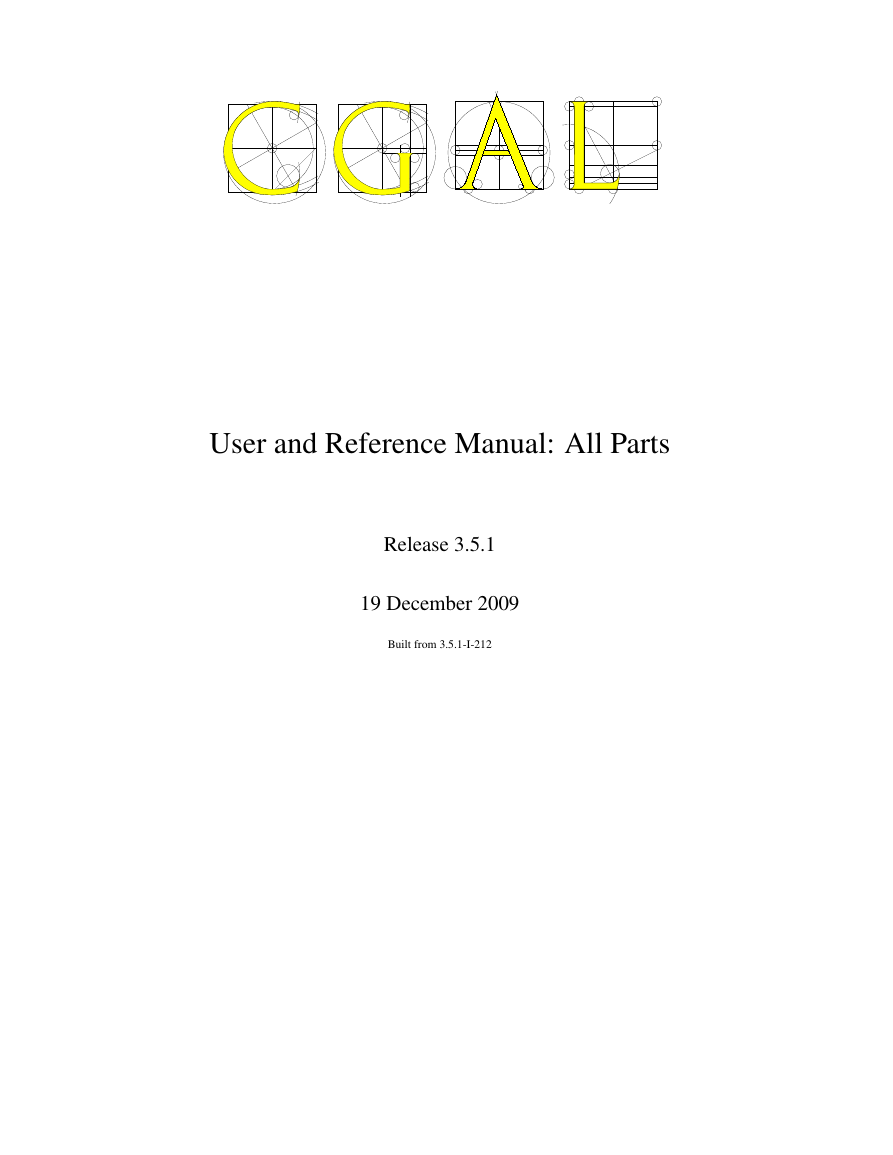

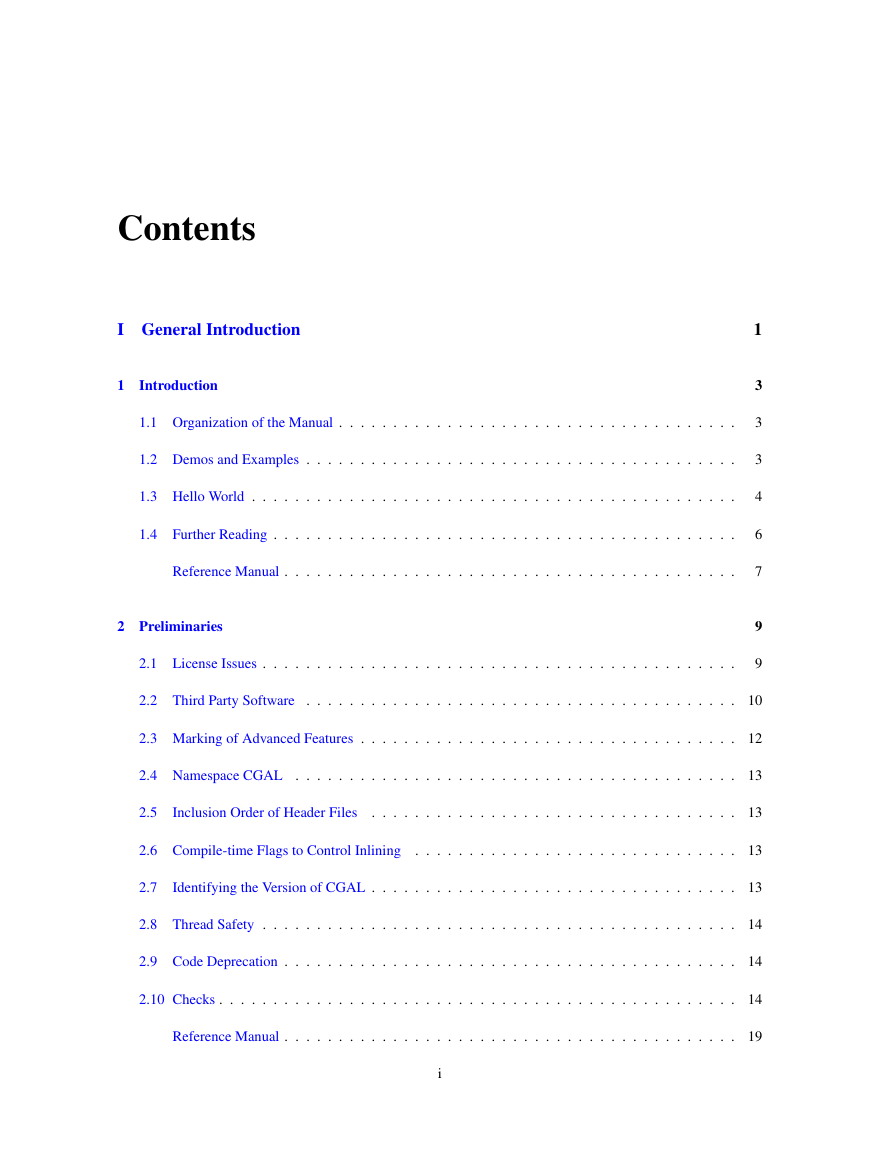

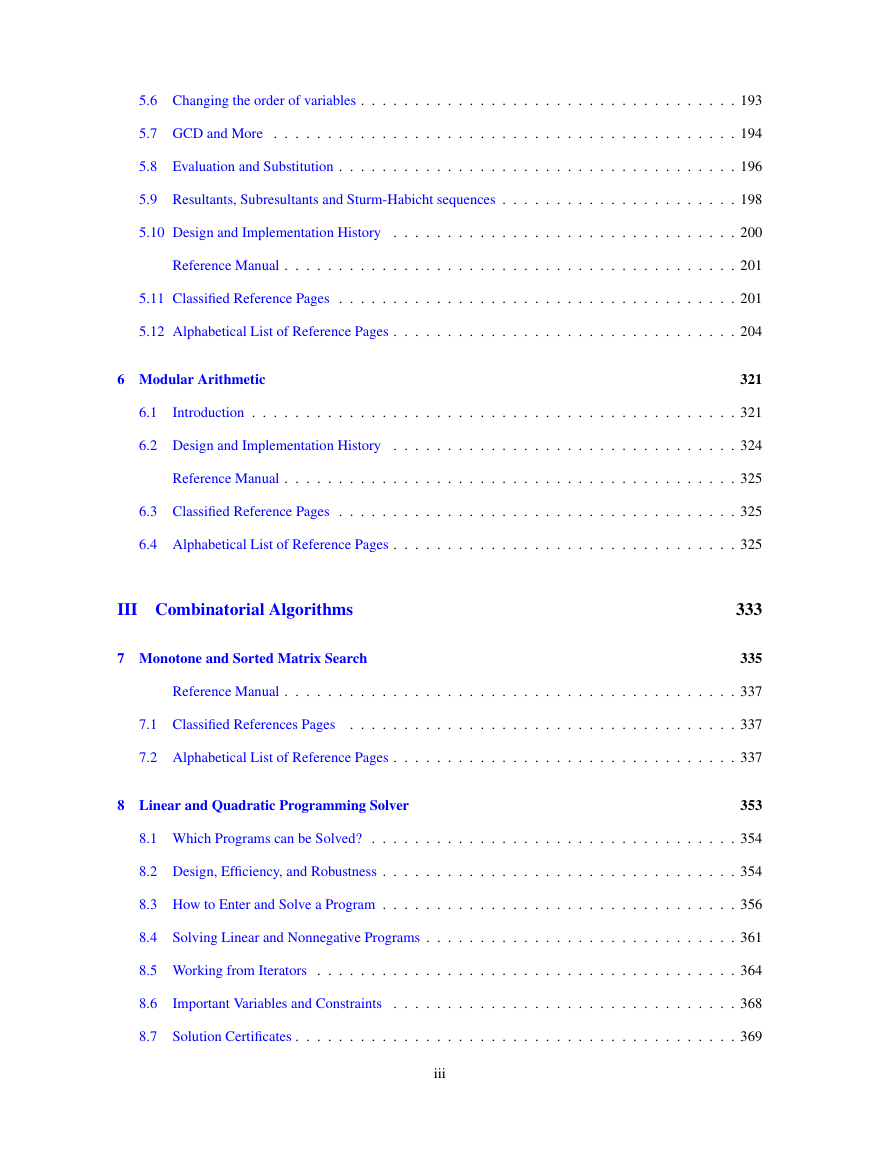
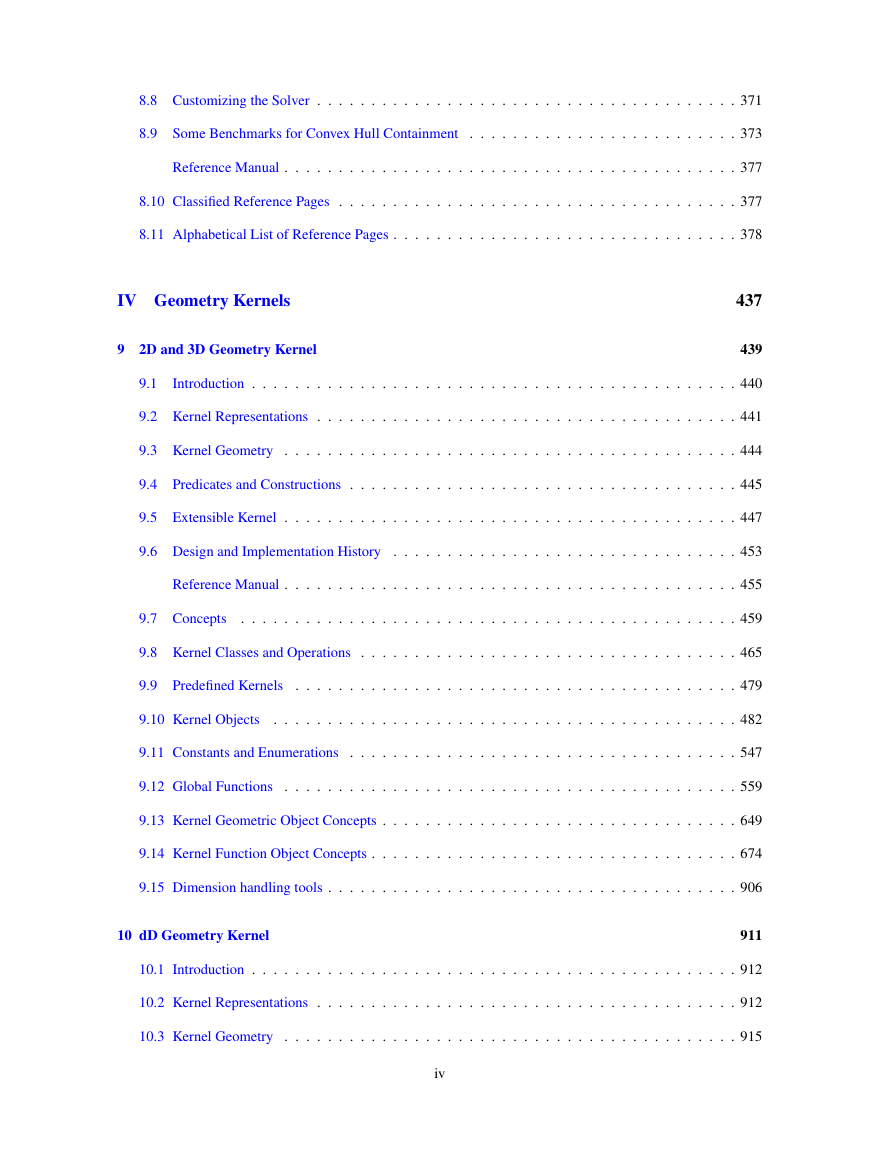
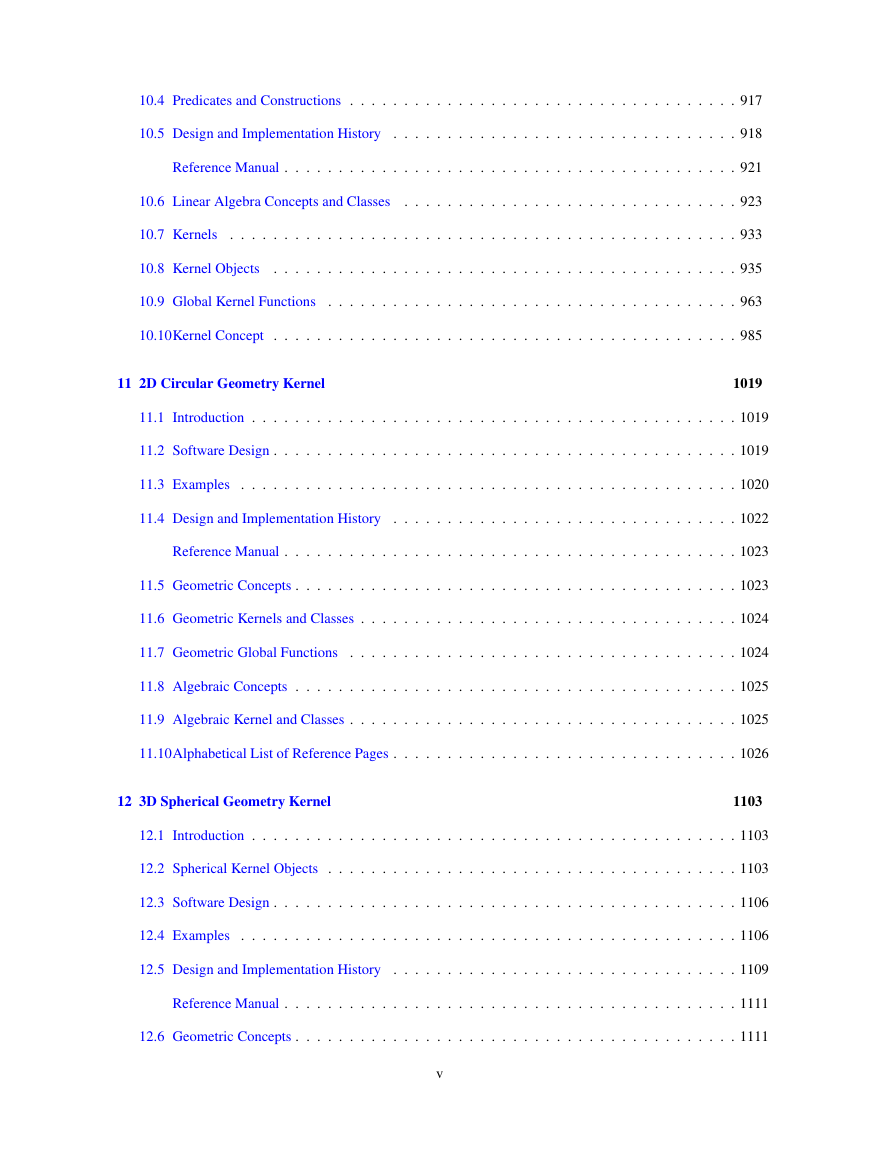
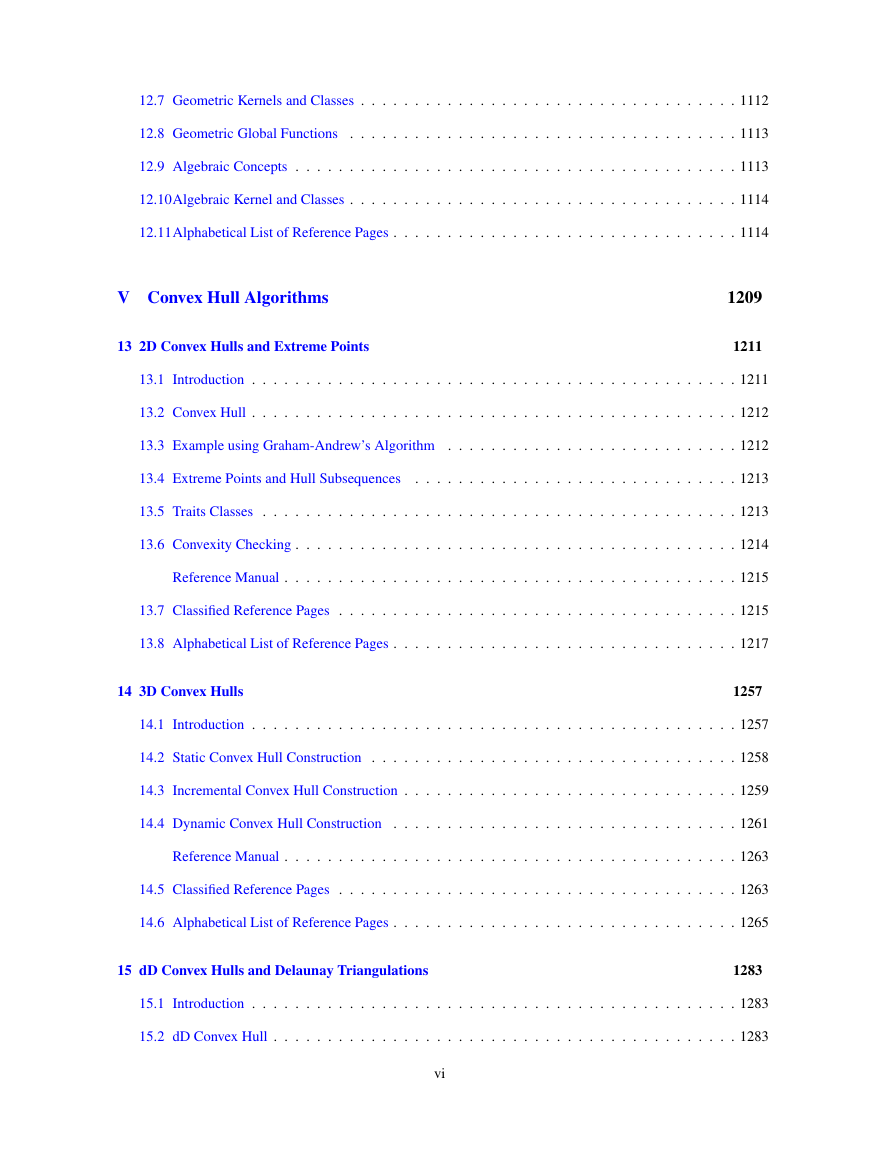








 2023年江西萍乡中考道德与法治真题及答案.doc
2023年江西萍乡中考道德与法治真题及答案.doc 2012年重庆南川中考生物真题及答案.doc
2012年重庆南川中考生物真题及答案.doc 2013年江西师范大学地理学综合及文艺理论基础考研真题.doc
2013年江西师范大学地理学综合及文艺理论基础考研真题.doc 2020年四川甘孜小升初语文真题及答案I卷.doc
2020年四川甘孜小升初语文真题及答案I卷.doc 2020年注册岩土工程师专业基础考试真题及答案.doc
2020年注册岩土工程师专业基础考试真题及答案.doc 2023-2024学年福建省厦门市九年级上学期数学月考试题及答案.doc
2023-2024学年福建省厦门市九年级上学期数学月考试题及答案.doc 2021-2022学年辽宁省沈阳市大东区九年级上学期语文期末试题及答案.doc
2021-2022学年辽宁省沈阳市大东区九年级上学期语文期末试题及答案.doc 2022-2023学年北京东城区初三第一学期物理期末试卷及答案.doc
2022-2023学年北京东城区初三第一学期物理期末试卷及答案.doc 2018上半年江西教师资格初中地理学科知识与教学能力真题及答案.doc
2018上半年江西教师资格初中地理学科知识与教学能力真题及答案.doc 2012年河北国家公务员申论考试真题及答案-省级.doc
2012年河北国家公务员申论考试真题及答案-省级.doc 2020-2021学年江苏省扬州市江都区邵樊片九年级上学期数学第一次质量检测试题及答案.doc
2020-2021学年江苏省扬州市江都区邵樊片九年级上学期数学第一次质量检测试题及答案.doc 2022下半年黑龙江教师资格证中学综合素质真题及答案.doc
2022下半年黑龙江教师资格证中学综合素质真题及答案.doc